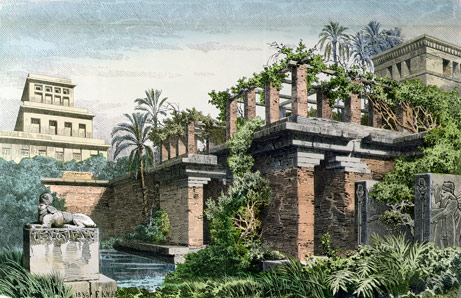How Nebuchnezzar Water The Rooftop Gardens

No one knows the location of the fabled Hanging Gardens of Babylon, one of the supposed Seven Wonders of the World, or whether it really ever existed. Greek and Roman writers described the gardens "amid the hot, arid landscape of ancient Babylon [where] lush vegetation cascades like waterfalls down the terraces of the gardens from seventy-five feet high. Trees, exotic plants, herbs and flowers, and sweet fragrances sweep through this oasis paradise of tall stone columns."
But those writers had never been there. They were writing only second-hand, possibly based on some oral tradition. There were no first-hand written accounts except for one Berossus, a Chaldean priest a Hellenistic-era Babylonian writer and astronomer who wrote in the Koine Greek language in the late fourth century B.C.E.In his book, Babyloniaca , he described and attributed rooftop gardens to Nebuchadnezzar II of Babylon. That's where the legend supposedly begins.
The Neo-Babylonian king built a series of hanging gardens alongside a grand palace for his homesick Median wife, Queen Amytis. She had been given to him in marriage as a political alliance between the two kingdoms. The gardens themselves did not really hang but rather were constructed on a series of rooftop, multi-level terraces supported by columns of baked brick — similar to the artist's conception pictured above.
Archaeological excavations of the palace on the site of ancient Babylon, in present-day Iraq, confirms evidence of a building with vaults and an irrigation system of, it is surmised, pumps, waterwheels, and cisterns to transport water up from the Euphrates River. The technical expertise of that time would have allowed for such an operation. Yet the lack of contemporary documentation casts doubt that these ruins are the real thing, or that the Hanging Gardens of Babylon even existed. Were they a historical mirage fueled by fertile imaginations?
Nevertheless, the Gardens did exist, just not in Babylon. As evidenced by new translations of ancient cuneiform texts, the Gardens were constructed 300 miles north, in Nineveh, by the Assyrian King Sennacherib in the early seventh century B.C.E. The Assyrians conquered Babylon in 689 B.C.E. and referred to Nineveh as "New Babylon" — or, Neo-Babylon — thus giving rise to later confusion by the time of Berossus.
According to a History Channel story, excavations around present-day Mosul, Iraq, have revealed evidence of an extensive aqueduct system built to transport water from the mountains, following a tradition of Assyrian royal garden building.
Bronze bas reliefs from the royal palace depict a lush garden. A sculptured wall panel is inscribed:
"Sennacherib king of the world . .. Over a great distance I had a watercourse directed to the environs of Nineveh, joining together the waters . . . Over steep-sided valleys I spanned an aqueduct of white limestone blocks. I made those waters flow over it . . ."
The ancient legend is substantiated, after all, just in a different place.
Many if not most of these bronze bas reliefs are now housed in British and American museums.

Sadly, many works left in situ were deliberately destroyed in the Mosul offensive during the Iraqi wars in late 2016.

This Assyrian relief from Nineveh (now housed at the British Museum) shows trees hanging in the air on terraces and plants suspended on stone arches that resemble those from Sennacherib's waterways, supporting the idea of a hanging garden at Nineveh.
So, what grew in these lush gardens cascading over a man-made mountain of terraces? Certainly orchards of pears, pomegranate, quince, date palms, and fig groves and grape vines. Other trees would have been almond, ebony, rosewood, olive, even oak and tamarisk, walnut, terebinth, ash, as well as fir, pines, cypresses, and junipers. With water, anyone can create a paradise in a desert.
- See also:
Hanging Gardens of Babylon … in Assyrian Nineveh
Sennacherib's garden without a rival
https://www.biblicalarchaeology.org/daily/ancient-cultures/ancient-near-eastern-world/hanging-gardens-of-babylon-in-assyrian-Nineveh
- For more images, Google "Hanging Gardens of Nineveh"
Author: www.rosesintherainmemoir.wordpress.com
Just short of fifty years of holy matrimony, I am blessed to be a mother of two and grandmother of seven. Much of my writing speaks to the culture and tradition of the Deep South, where I spent the first thirty-five years of my life before relocating to the Pacific Northwest. As a poet and essayist, I've published both online and in print media. In mid-February 2019, I launched Roses in the Rain: A Daughter's Story, following a successful couple years of Invitation to the Garden, both on WordPress.com. Watch for upcoming installments to the memoir blog every Tuesday. The garden posts follow on Friday/Saturday. I look forward to hearing from you all! View all posts by www.rosesintherainmemoir.wordpress.com
How Nebuchnezzar Water The Rooftop Gardens
Source: https://invitationtothegarden.wordpress.com/2018/06/07/hanging-gardens-of-nineveh/
Posted by: washingtonmorave.blogspot.com

0 Response to "How Nebuchnezzar Water The Rooftop Gardens"
Post a Comment